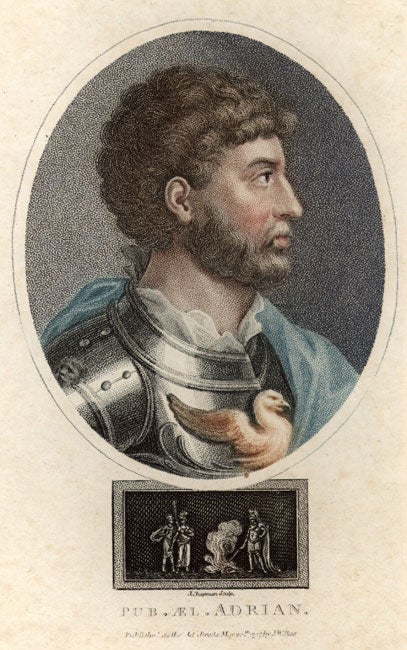Hadrian the gay emperor
His attempt to fortify the Roman Empire is well known. But an exhibition focuses on another side of the man. By Arifa Akbar

The bust is classically Roman, the face imperious. But this is no ordinary emperor. As a major new exhibition at the British Museum makes clear, Publius Aelius Traianus Hadrianus was not only a peacemaker who pulled his soldiers out of modern-day Iraq. He was also the first leader of Rome to make it clear that he was gay.
Hadrian: Empire and Conflict will see the bust make pilgrimages to both ends of Hadrian's Wall, the first time it has left the British Museum since being found in the Thames 200 years ago. But it is the singular life-story of the gay emperor that is likely to capture the interest of most visitors.
After being made emperor AD117, he inherited a Roman Empire in its prime, which had thrived on a policy of endless expansion and conquest.
His first move, within hours of coronation, was to withdraw his troops from Mesopotamia, now Iraq, and fortify the empire's boundaries by building his eponymous wall in northern England and others in the Danube and the Rhine valleys, ushering in a new era of peace. The reign that followed can be traced through 200 ancient treasures, many of which have never been display in Britain.
Several of the artefacts relate to his male consort, Antinous, who accompanied him on his travels around the empire. These items include a poem written on papyrus, featuring the two men hunting together, and new finds that include memorials to the dead lover at Hadrian's villa in Tivoli.
Although it was not uncommon for his predecessors to have taken gay lovers alongside a female spouse, Hadrian was unique in making his love "official" in a way that no other emperor had before him.
When Antinous drowned in mysterious circumstances, Hadrian was so distraught that he chose to commemorate the young Greek by naming an Egyptian city in his honour. Thorsten Opper, curator of the exhibition, said what was unusual in Hadrian's attitude towards Antinous was the way in which he publicly deified him.
"He had to marry, and he had a politically arranged marriage to Sabina, who was the great-niece of the former emperor Trajan, which in effect, set up his succession. But clearly, it was a loveless marriage with no children. What was unusual is that he had a lot of flings, and then after his lover drowned in the Nile AD130 he made him a god.
"Hadrian was clearly bereaved and he had lots of images put up. When a city was founded close to the spot where Antinous drowned, he named it Antinopolis. It was a sort of hero cult-worship of Antinous," he said.
The emperor's sexuality was by no means the only unusual aspect of his reign. The decision to pull his troops out of Mesopotamia might have been frowned upon in an empire that had built its might on a bellicose foreign policy, but Hadrian's charisma won over the masses.
Neil MacGregor, director of the British Museum, said: "The exhibition will provide an opportunity to assess the important legacy of the emperor Hadrian, a classical figure whose reign has telling relevance to our lives today."
Mr Opper said there were similarities between second-century Mesopotamia and present-day Iraq, with the Roman occupiers finding themselves in a hotbed of violence and resistance.
"We must not mistake [Hadrian's] motives for pulling his troops out of Mesopotamia," Mr Opper said. "He didn't really have a choice. It had just been conquered by his predecessor and there was a lot of guerrilla warfare, which is eerily just like modern times. What he did was give the empire breathing space and while he was a very experienced military leader, we also get the impression he was very cultured and he fostered Greek identity and made them partners in leadership."
As the "people's king" – he travelled with his troops and ate the same rations – he laid the foundations of the Byzantine Empire and changed the name of Judea to create Palestine, among other legacies.
At times, however, even Hadrian's Rome played the role of violent occupier. During a suppression of a Jewish rebellion in Judea, Roman warriors were dispatched to take control ofthe region, leading to the death of 580,000 Jews. "It was probably as a punishment that he changed the name of Judea to Palestine," said Mr Opper.
The exhibition, which brings together loans from 31 countries, will display sculpture, bronzes and architectural fragments. Highlights include the Vindoanda tablets from Hadrian's Wall and a bronze head of the emperor discovered in the Thames in 1834, which will travel to both ends of Hadrian's Wall. The head comes from a statue that may have been erected in a public space in London AD122 to commemorate Hadrian's visit to Britain.
Other highlights are a bronze bust from Israel found in 1975, a papyrus fragment of Hadrian's autobiography from the Bodleian Library that has never before been on public display, fragments from Hadrian's tomb and gilded bronze peacocks measuring two metres lent by the Vatican's Museum for the first time.
The show runs from 24 July until 26 October
Join our commenting forum
Join thought-provoking conversations, follow other Independent readers and see their replies
Comments